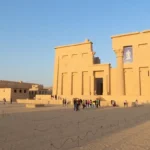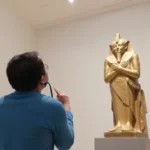30 Fascinating Facts About Egypt You Might Not Know

When it comes to captivating travel destinations, few places rival Egypt, a land steeped in ancient history and enveloped in mystery. From the majestic pyramids to the enigmatic Sphinx, Egypt's allure draws millions of visitors each year. In this article, we delve into 30 intriguing facts about Egypt that you may not be aware of, offering a glimpse into its rich heritage.
Did you know that the Great Pyramid of Giza was the tallest man-made structure for over 4,000 years? Or that the color white represented mourning in ancient Egypt? Let's explore these fascinating aspects and more:
Unveiling Egypt's Ancient Wonders
1. The Great Pyramid of Giza is renowned as the only surviving structure of the original Seven Wonders of the Ancient World. This colossal edifice consists of over 2 million stone blocks, each weighing more than 2 tons. A remarkable fact is that the three pyramids of Giza are aligned with the Orion constellation.
2. While the Giza pyramids are iconic, Egypt boasts around 120 pyramids spread across the country. Surprisingly, it is not the nation with the most pyramids; that title goes to Sudan, which has over 250 pyramids.
3. The Pyramid of Khufu, or Cheops, held the title of the largest building in the world for approximately 4,000 years until the construction of Lincoln Cathedral's bell tower in the 14th century.
4. Not only is it the largest, but it is also considered the heaviest building in the world today!
The Mystique of Tutankhamun
5. Tutankhamun, often called King Tut, ruled for a short period and is famous not for his achievements but for the discovery of his tomb, which was untouched by looters. His treasures are now housed in the Cairo Museum. Interestingly, the cause of his death remains uncertain, with theories suggesting he suffered a catastrophic accident, as he was embalmed without a rib cage. Some even speculate that he might have been killed by a hippopotamus!
6. Contrary to popular belief, the pyramids were not built by slaves but rather by skilled laborers. Archaeological discoveries include graves of these workers near the pyramids, indicating that they were respected individuals who earned wages.
Engineering Marvels and Timekeeping
7. While the pyramids and temples capture most of the attention, the Suez Canal, constructed between 1859 and 1869, revolutionized international trade by connecting the Mediterranean Sea to the Red Sea.
8. The ancient Egyptians used a unique calendar with three primary seasons: planting, flooding, and harvesting, reflecting their deep connection to agriculture and the Nile River.
9. The pharaoh was regarded as a living deity, and the reverence of the people was immense. However, this did not prevent workers during Ramses III's reign from organizing the first recorded strike in history due to unpaid wages in grain, compelling the pharaoh to meet their demands.
10. The term “pharaoh” translates to “great house” in ancient Egypt, symbolizing that the pharaoh's body was a vessel for a god's soul. For more insights, check out the ten most significant pharaohs of Egypt.
The Language and Lifestyle of Ancient Egypt
11. The ancient writing system known as hieroglyphs derives its name from the Greek word hieroglúphos, meaning “sacred carving.”
12. Deciphering hieroglyphs took centuries, with the breakthrough coming from the Rosetta Stone. French scholar Jean-François Champollion revealed that many symbols represented sounds rather than ideas.
13. Contrary to popular belief, hunger was not a prevalent issue in ancient Egypt. Many analyzed mummies showed signs of obesity, suggesting a diet rich in food.
14. Ancient Egyptians were known for their grooming habits; both men and women used substantial amounts of makeup. They utilized kohl, a mixture of minerals and water, to adorn their eyes, and perfumes made from oils, spices like cinnamon, and resins such as myrrh were widely used.
Pets, Mourning, and Rituals in Ancient Egypt
15. Archaeological discoveries revealed that ancient Egyptians were pioneers in creating prosthetics, with evidence of wooden arms and fingers.
16. Egyptians cherished their pets, primarily dogs, cats, and monkeys. Mourning rituals included cutting their hair as a sign of grief when a pet passed away, and some families opted to mummify their beloved animals for the afterlife.
17. Interestingly, white was the color of mourning in ancient Egypt, while black symbolized good fortune, as the dark soil from the Nile flooding enriched the land for agriculture.
18. Statues from ancient Egypt often share common characteristics based on the subject's life status: if the person was alive, the statue featured a straight beard and the left foot forward, symbolizing life; once deceased, the beard pointed outward with both feet aligned.
19. The Egyptian civilization exhibited a degree of gender equality that was progressive for its time. Women enjoyed many rights, including the ability to work, manage finances, buy and sell property, and remarry after divorce.
Symbols and Beliefs of Ancient Egypt
20. One of the most recognized symbols in Egypt is the scarab beetle, which represents resurrection and eternal life.
21. Another sacred symbol is the Ankh, or the cross ansata, symbolizing life and mastery over death.
22. The ancient Egyptians practiced polytheism, worshipping numerous deities. However, some pharaohs, like Akhenaten, attempted to shift the populace towards monotheism, promoting the worship of the sun god, Atón.
The Modern Symbols of Egypt
23. The flag of Egypt features three horizontal stripes with distinct meanings:
- Red: symbolizes the blood shed in wars and revolutions.
- White: where the eagle of Saladin is depicted, representing Arab identity and independence.
- Black: a reminder of the period of monarchy and British colonialism.
24. Egyptian deities were typically depicted with animal heads and human bodies. For instance, Sobek, the god of the Nile, had the head of a crocodile, while Horus, the sun god, was shown with a falcon's head.
Life, Death, and Innovations in Ancient Egypt
25. Those who could afford it purchased the Book of the Dead, an expensive guide intended for use in the afterlife, filled with spells and formulas to ensure a safe passage.
26. Many individuals could not afford mummification due to its high costs. However, the dry desert conditions naturally preserved bodies buried in its sands.
27. Egypt had its own version of a Leonardo da Vinci in Imhotep, who is celebrated as the first engineer, architect, geometer, and physician in history. He designed the Step Pyramid of Djoser, the earliest known pyramid.
28. It is common to see ancient statues of pharaohs holding objects like scepters or scrolls. Initially thought to signify power, it was ultimately revealed to be an architectural technique to strengthen the statue's structure.
29. Surprisingly, Cleopatra VII was not Egyptian; she belonged to the Greek Ptolemaic dynasty. Renowned for her intelligence and beauty, she was the last pharaoh of Egypt before the country fell under Roman rule.
30. Many Egyptian inventions have made their way into modern life, such as the key and lock, cosmetics, toothbrushes, combs, scissors, and even wigs!
There are countless more fascinating facts about Egypt and its ancient civilization. These insights merely scratch the surface. What other curiosities do you know about Egypt?
Keep up with our adventures in Egypt through our Instagram stories.
For more travel tips, compare and find cheap flights here.
Discover accommodation at the best prices here.
Book activities and excursions in Spanish here.
Get a 5% discount on your travel insurance with IATI here.
Reserve airport transfers here.
Find out how to withdraw money without fees here.
Enjoy a 5% discount on your eSIM from Holafly here.
Check out the best books and travel guides here.
Explore all our articles about Egypt.




Deja una respuesta